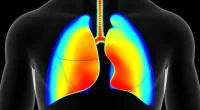Pneumococcal Peril: New Study Exposes Gaps in Vaccines Coverage, Paving the Way for Advanced Immunization Strategies
A recent study published in The Lancet Regional Health highlights the need for advanced pneumococcal vaccines. The study found that people under 65 with no pneumococcal risk factors are more likely to develop pneumonia with a PCV20-non13 serotype than other serotypes. The researchers recommend the use of higher-valency vaccines to avert considerable numbers of pneumococcal CAP cases in older adults.
Background
Streptococcus pneumoniae is the most common causative pathogen of community-acquired pneumonia (CAP). Scientists have identified over 100 pneumococcal serotypes, but only two, a 23-valent pneumococcal polysaccharide vaccine (PPV23) and pneumococcal conjugate vaccines (PCVs), are used in pneumococcal vaccines.
After PCV implementation in the UK, vaccine-serotype invasive pneumococcal disease (IPD) declined in all age groups, but pneumonia caused by non-PCV serotypes surged. A recent study showed that despite the introduction of PCV10/13 vaccines into national childhood immunization programs in the UK, PCV13 serotypes caused nearly 50% of pneumococcal CAP.
About the study
The present study team screened all acute admissions per study eligibility criteria daily and reviewed cases within 48 hours of admission. They treated patients aged ≥16 with one or more symptoms of a lower respiratory tract (LRT) infection and abnormalities indicating chest infection on a chest radiograph as a CAP patient.
Pneumococcal CAP patients were diagnosed based on the following three criteria:
- Positive pneumococcal UAD
- Blood culture positive for S. pneumoniae
- Positive report on the Bio-Plex24 assay
The statistical analysis included all patients with radiologically confirmed CAP, classifying serotypes based on pneumococcal vaccines and excluding patients with multiple serotypes detected in the same sample.
Serotypes based on the content of pneumococcal vaccines were PCV13, PCV15, PCV20non13, PPV23non13, and non-vaccine types (NVT) or untyped disease.
The researchers used multivariable logistic regression to analyze the association between different serotypes and comorbidity, adjusting for age, gender, residential care status, prior vaccination, and specific comorbidities.
They also analyzed the risk of pneumococcal CAP in different clinical risk groups based on age (ages 16-64 and ≥ 65) and specific risk factors (chronic diseases, immunosuppression).
READ MORE NEWS: Smoking Habits and Mortality in China: A Call for Action
Results

Of 2,249 potential participants identified across the three sites, 1,921 adults hospitalized with CAP, of which 7.8% were admitted to critical care units, made it to the final analysis sample set. The median age of these people was 70 years, and most were male patients.
The authors diagnosed 781 patients with pneumococcal CAP, with 78 (10%) showing a positive pneumococcal blood culture. Of these, 149 samples had multiple serotypes.
The large proportion of hospitalized CAP patients (40.7%) who had single serotype pneumococcal CAP were predominantly due to serotypes covered by PCV13 and PCV15.
The PCV13 serotype pneumonia was more common in older patients and associated with a higher risk of death within 30 days and male sex. The two most prevalent serotypes in the study cohort were serotypes 3 (70.4%) and 19A (16.9%).
Likewise, ~49.4% of patients had pneumonia caused by a PCV15 serotype, with serotypes 22F and 33F being the most common. A cerebrovascular disease was a risk factor for pneumonia caused by these serotypes.
These observations are notable as these serotypes caused pneumococcal CAP despite relatively high vaccine coverage in 2019–2020 in the UK, i.e., 71.5% and 90.5% for adults ≥65 years and infants, respectively.
Moreover, the shift away from PCV13 serotypes following the introduction of infant PCV13 immunization was unsubstantial, reflecting lower vaccine efficacy against PCV13 serotypes and the persistence of serotype 3.
Further, they detected PCV20-non13 serotypes in 24.6% of patients with pneumococcal CAP, with lower odds in males and those who had received the PPV23 vaccine.
These cases occurred more in younger people without clinical risk factors, and these patients had lower odds of readmission within 30 days.
Moreover, PPV23 serotypes accounted for 74.8% of pneumococcal CAP, with PPV23-nonPCV13 serotype CAP being more common in younger individuals and less common in males.
Serotype Replacement and the Need for Higher-Valency Vaccines
The study highlights the phenomenon of serotype replacement, where pneumococcal strains not included in current vaccines become dominant. This underscores the need for higher-valency vaccines, which cover a wider range of serotypes.
- The study found that PCV20-non13 serotypes were relatively common in younger adults, indicating that current PCV13 and PCV15 vaccines may not adequately protect this age group. Higher-valency vaccines could potentially prevent these infections.
- The persistence of serotype 3, despite widespread PCV13 vaccination, further emphasizes the limitations of current vaccines. New vaccines with improved efficacy against this serotype are crucial.
Monitoring and Adapting in the Post-Pandemic Era
The study was conducted before the COVID-19 pandemic, which significantly altered healthcare practices and impacted the epidemiology of infectious diseases. It’s crucial to monitor how the pandemic has affected pneumococcal serotype distribution and adjust vaccine strategies accordingly.
- Continued surveillance of pneumococcal serotypes in the post-pandemic era is essential to identify any shifts in dominance and assess the effectiveness of existing vaccines.
- The study suggests that higher-valency vaccines could significantly benefit older adults, who are at higher risk for pneumococcal complications. Monitoring their impact in this population is crucial.
READ MORE NEWS: Alzheimer’s Disease Treatment: Novel Exosome-Based Drug Delivery System Shows Promise
Future Directions and Considerations
The development and implementation of new higher-valency pneumococcal vaccines hold promise for preventing a significant portion of pneumococcal CAP cases. However, several important considerations remain:
- Cost-effectiveness: Balancing the potential benefits of broader vaccine coverage with the associated costs requires careful analysis.
- Vaccine hesitancy: Addressing vaccine hesitancy and promoting vaccination, particularly in high-risk groups, is crucial for maximizing the impact of new vaccines.
- Global access: Ensuring equitable access to new vaccines, particularly in low- and middle-income countries, requires international cooperation and support.
Conclusion
This study provides valuable insights into the evolving landscape of pneumococcal CAP and highlights the need for continued research and development of advanced vaccines. By monitoring serotype distribution, adapting to new challenges like the pandemic, and addressing key considerations, we can pave the way for a future with significantly fewer pneumococcal infections and improved public health outcomes. Study source
Continue to check our website soundhealthandlastingwealth.com for more articles of this kind. And, please use our comment section as well, we would love to hear from you.









